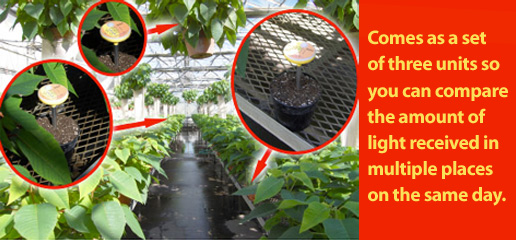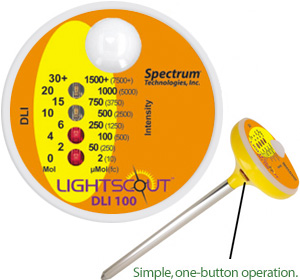|
Insufficient Light Levels Can Negatively Affect Plant Growth.
Do you ever wonder how much your greenhouse light decreases every time you pull a shade cloth?
While a standard shade cloth helps reduce excessive heat, it also decreases light by as much as 50 percent.
Do you wonder how much your greenhouse glass filters incoming light?
Thirty to 70 percent of your plants' light exposure can be blocked by the glass. Dirty glass and aged glass are the worst culprits.
Are your hanging baskets preventing bench plants from getting the amount of light they need?
If not spaced properly, hanging baskets will block light from reaching the plants positioned below.
As you know, light is the driving force for photosynthesis and therefore essential to greenhouse and nursery plant production. Plant rooting, growth and development are influenced significantly by the quantity and consistency of light. However, the transmission of light can be highly variable. Therefore, in order for light to be managed properly, it needs to be measured precisely. However, many growers choose to use old-school methods of light measurement: either eyeballing and estimating light levels or using a hand-held light meter. Neither method is effective. Using an eyes-only approach is subjective and invites a huge margin for error. A hand-held meter is limited by measuring light only during a single point in time, not cumulative light throughout the day.
So what's the solution? When growers replace subjective light measurement with objective light-measuring technology, only then are they able to properly manage light and achieve more predictable, consistent plant production.
Accurately Measuring Light Levels Gives Your Operation an Advantage.
The cumulative amount of light received by your plants during a 24-hour period is called the Daily Light Integral, or DLI, and is measured in units of "moles per day." DLI quantifies the light available to plants to perform photosynthesis and, as a general rule, plants need a minimum DLI of 10 moles per day. On a sunny winter day in the middle latitudes, a plant receives about nine moles per day. During a cloudy winter day, the DLI drops to three moles per day. In the summer, the DLI for a sunny day is about 26 moles per day and the DLI for a cloudy day is 12 moles per day. Of course, each type of plant has a different DLI range for optimal growth. DLI is directly correlated with plant quality, and a minimum amount of light is required for marketable plants. Measuring DLI over a growing season and comparing it to results can help you determine how to manage or manipulate light to make your operation more profitable. If you have been estimating light levels with your eyes or with a low-tech hand-held meter, you can be sure you are sacrificing accuracy. A more precise, more effective method is to use professional measuring devices such as our LightScout® DLI 100 Light Meters. These portable, battery-operated meters are an affordable first step in measuring DLI to help you produce high-quality plants more efficiently and effectively.
Improve Your Plant Production with LightScout® DLI 100 Light Meters

 Measure the light "falling" on your plants: Measure the light "falling" on your plants:
-
Simple, one-button operation
-
Displays light intensity levels every four seconds for 24 hours
-
An affordable, first step in measuring light
-
Measure PAR (Photosynthetically Active Radiation) light
-
With the push of a button, the meter runs for 24 hours and calculates your Daily Light Integral (DLI)
-
Real-time intensity levels are shown every four seconds in µmol·m-2s-1 (or foot·candles)
-
Packaged in sets of three light meters
-
Battery included; water resistant
|
Numbers to the right of the vertical LEDs are used during the Light Gathering Period to indicate current light levels in µmol·m-2s-1 (micromoles) or fc (foot·candles - using the sunlight approximation of 1 µmol·m-2s-1 = 5 fc). After 24 hours, the LEDs flash once per second to display the DLI value in moles/day using the numbers to the left of the LEDs.
Learn more about LightScout® Light Meters!
|
 |
Have questions? Call toll free: (800) 248-8873
|